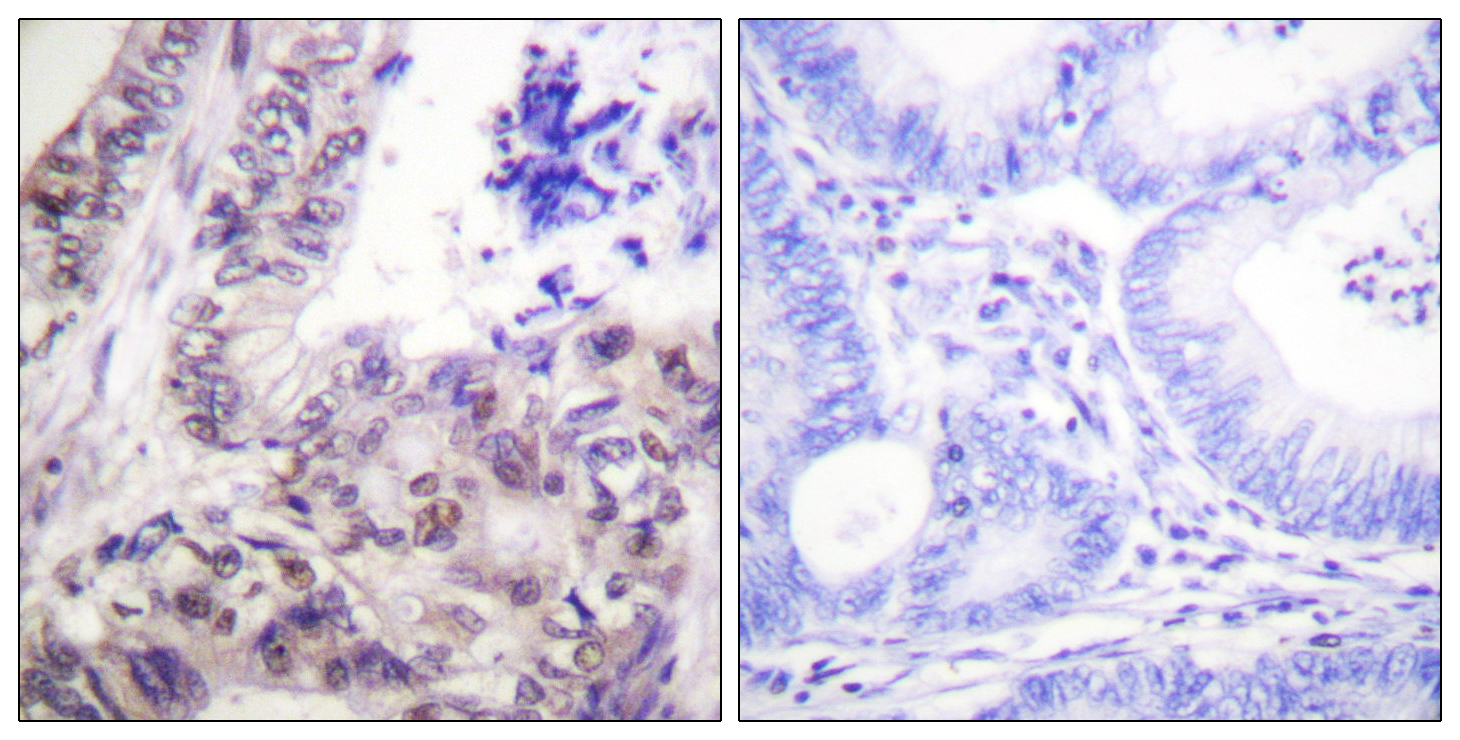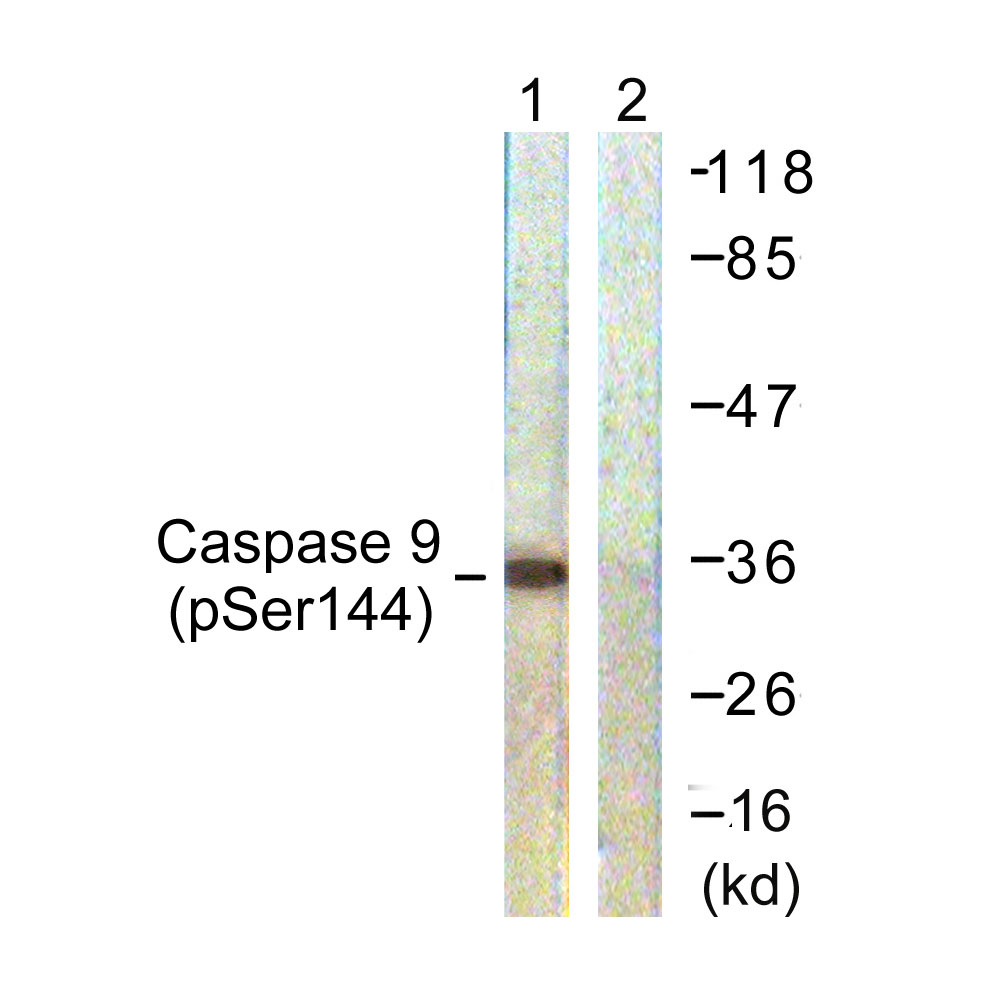Caspase-9 (phospho Ser144) Polyclonal Antibody
- Catalog No.:YP0726
- Applications:WB;IHC;IF;ELISA
- Reactivity:Human;Rat;Mouse;
- Target:
- Caspase-9
- Fields:
- >>Platinum drug resistance;>>p53 signaling pathway;>>PI3K-Akt signaling pathway;>>Apoptosis;>>Apoptosis - multiple species;>>VEGF signaling pathway;>>Thyroid hormone signaling pathway;>>Alzheimer disease;>>Parkinson disease;>>Amyotrophic lateral sclerosis;>>Huntington disease;>>Prion disease;>>Pathways of neurodegeneration - multiple diseases;>>Pathogenic Escherichia coli infection;>>Legionellosis;>>Toxoplasmosis;>>Tuberculosis;>>Hepatitis C;>>Hepatitis B;>>Measles;>>Human cytomegalovirus infection;>>Influenza A;>>Kaposi sarcoma-associated herpesvirus infection;>>Herpes simplex virus 1 infection;>>Epstein-Barr virus infection;>>Human immunodeficiency virus 1 infection;>>Pathways in cancer;>>Colorectal cancer;>>Pancreatic cancer;>>Endometrial cancer;>>Prostate cancer;>>Small cell lung cancer;>>Non-small cell lung cancer;>>Viral myocarditis;>>Lipid and atherosclerosis
- Gene Name:
- CASP9
- Protein Name:
- Caspase9
- Human Gene Id:
- 842
- Human Swiss Prot No:
- P55211
- Immunogen:
- The antiserum was produced against synthesized peptide derived from human Caspase 9 around the phosphorylation site of Ser144. AA range:110-159
- Specificity:
- Phospho-Caspase-9 (S144) Polyclonal Antibody detects endogenous levels of Caspase-9 protein only when phosphorylated at S144.
- Formulation:
- Liquid in PBS containing 50% glycerol, 0.5% BSA and 0.02% sodium azide.
- Source:
- Polyclonal, Rabbit,IgG
- Dilution:
- WB 1:500 - 1:2000. IHC 1:100 - 1:300. ELISA: 1:20000.. IF 1:50-200
- Purification:
- The antibody was affinity-purified from rabbit antiserum by affinity-chromatography using epitope-specific immunogen.
- Concentration:
- 1 mg/ml
- Storage Stability:
- -15°C to -25°C/1 year(Do not lower than -25°C)
- Other Name:
- CASP9;MCH6;Caspase-9;CASP-9;Apoptotic protease Mch-6;Apoptotic protease-activating factor 3;APAF-3;ICE-like apoptotic protease 6;ICE-LAP6
- Observed Band(KD):
- 35kD
- Background:
- CASP9 encodes a member of the cysteine-aspartic acid protease (caspase) family. Sequential activation of caspases plays a central role in the execution-phase of cell apoptosis. Caspases exist as inactive proenzymes which undergo proteolytic processing at conserved aspartic residues to produce two subunits, large and small, that dimerize to form the active enzyme. Caspase 9 can undergo autoproteolytic processing and activation by the apoptosome, a protein complex of cytochrome c and the apoptotic peptidase activating factor 1; this step is thought to be one of the earliest in the caspase activation cascade. Caspase 9 is thought to play a central role in apoptosis and to be a tumor suppressor. Alternative splicing results in multiple transcript variants.
- Function:
- catalytic activity:Strict requirement for an Asp residue at position P1 and with a marked preference for His at position P2. It has a preferred cleavage sequence of Leu-Gly-His-Asp-|-Xaa.,function:Involved in the activation cascade of caspases responsible for apoptosis execution. Binding of caspase-9 to Apaf-1 leads to activation of the protease which then cleaves and activates caspase-3. Proteolytically cleaves poly(ADP-ribose) polymerase (PARP).,function:Isoform 2 lacks activity is an dominant-negative inhibitor of caspase-9.,online information:Caspase-9 entry,PTM:Cleavages at Asp-315 by granzyme B and at Asp-330 by caspase-3 generate the two active subunits. Caspase-8 and -10 can also be involved in these processing events.,similarity:Belongs to the peptidase C14A family.,similarity:Contains 1 CARD domain.,subunit:Heterotetramer that consists of two anti-parallel arranged heterodimers
- Subcellular Location:
- nucleus,mitochondrion,cytosol,apoptosome,
- Expression:
- Ubiquitous, with highest expression in the heart, moderate expression in liver, skeletal muscle, and pancreas. Low levels in all other tissues. Within the heart, specifically expressed in myocytes.
- June 19-2018
- WESTERN IMMUNOBLOTTING PROTOCOL
- June 19-2018
- IMMUNOHISTOCHEMISTRY-PARAFFIN PROTOCOL
- June 19-2018
- IMMUNOFLUORESCENCE PROTOCOL
- September 08-2020
- FLOW-CYTOMEYRT-PROTOCOL
- May 20-2022
- Cell-Based ELISA│解您多样本WB检测之困扰
- July 13-2018
- CELL-BASED-ELISA-PROTOCOL-FOR-ACETYL-PROTEIN
- July 13-2018
- CELL-BASED-ELISA-PROTOCOL-FOR-PHOSPHO-PROTEIN
- July 13-2018
- Antibody-FAQs
- Products Images

- Enzyme-Linked Immunosorbent Assay (Phospho-ELISA) for Immunogen Phosphopeptide (Phospho-left) and Non-Phosphopeptide (Phospho-right), using Caspase 9 (Phospho-Ser144) Antibody

- Immunohistochemistry analysis of paraffin-embedded human colon carcinoma, using Caspase 9 (Phospho-Ser144) Antibody. The picture on the right is blocked with the phospho peptide.

- Western blot analysis of lysates from K562 cells, using Caspase 9 (Phospho-Ser144) Antibody. The lane on the right is blocked with the phospho peptide.



